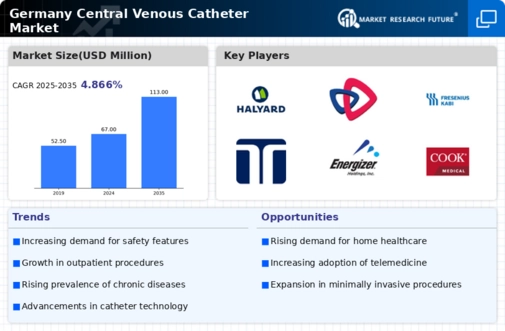Increasing Healthcare Expenditure
Germany's rising healthcare expenditure is a significant driver for the central venous-catheter market. The country allocates approximately 11.7% of its GDP to healthcare, reflecting a commitment to improving medical services and patient care. This financial investment facilitates the procurement of advanced medical devices, including central venous catheters, which are essential for various treatments. Furthermore, the German government has implemented policies aimed at enhancing healthcare infrastructure, which includes upgrading hospital facilities and expanding access to specialized care. As healthcare budgets continue to grow, the demand for high-quality medical devices is expected to rise, thereby positively impacting the central venous-catheter market.
Focus on Infection Control Practices
The emphasis on infection control practices within healthcare settings is a crucial driver for the central venous-catheter market. In Germany, healthcare facilities are increasingly adopting stringent protocols to minimize the risk of catheter-related infections. This focus is underscored by national guidelines that recommend the use of specific catheter types and insertion techniques to enhance patient safety. As a result, the demand for high-quality, infection-resistant central venous catheters is likely to increase. Moreover, educational initiatives aimed at training healthcare professionals in best practices for catheter management further support this trend. Consequently, the central venous-catheter market is expected to benefit from the heightened awareness and implementation of infection control measures.
Rising Incidence of Chronic Diseases
The increasing prevalence of chronic diseases in Germany is a primary driver for the central venous-catheter market. Conditions such as cancer, diabetes, and cardiovascular diseases necessitate long-term intravenous access for treatment. According to health statistics, chronic diseases account for approximately 70% of all deaths in Germany, highlighting the urgent need for effective management solutions. This trend is likely to propel the demand for central venous catheters, as healthcare providers seek reliable methods for administering medications and fluids. Furthermore, the aging population, which is projected to reach 22% by 2030, will further contribute to the market's growth. As more patients require ongoing treatment, the central venous-catheter market is expected to expand significantly in response to these healthcare challenges.
Growing Demand for Home Healthcare Solutions
The shift towards home healthcare solutions is emerging as a significant driver for the central venous-catheter market. With an increasing number of patients preferring to receive treatment at home, there is a rising need for medical devices that facilitate safe and effective home care. Central venous catheters are essential for patients requiring long-term intravenous therapy, such as those undergoing chemotherapy or long-term antibiotic treatment. The German healthcare system is adapting to this trend by promoting home healthcare services, which are projected to grow by 15% over the next five years. This shift not only enhances patient comfort but also reduces hospital readmission rates, thereby driving the demand for central venous catheters in the home healthcare segment.
Technological Innovations in Catheter Design
Innovations in catheter technology are transforming the central venous-catheter market in Germany. The introduction of advanced materials and designs, such as antimicrobial coatings and biocompatible materials, enhances patient safety and reduces the risk of infections. Recent studies indicate that the use of these innovative catheters can decrease infection rates by up to 30%. Additionally, the development of smart catheters equipped with sensors for real-time monitoring is gaining traction. These advancements not only improve patient outcomes but also streamline clinical workflows, making them attractive to healthcare providers. As hospitals and clinics increasingly adopt these technologies, the central venous-catheter market is poised for substantial growth, driven by the demand for safer and more effective medical devices.




















Leave a Comment